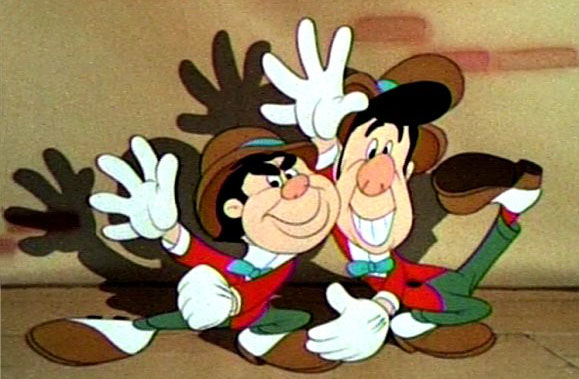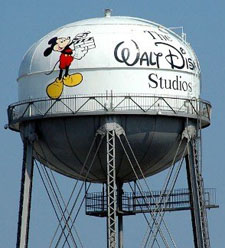
The Kimball, Kelly and Moore Show. In 1941, Sterling Silliphant who was then the publicity director at the Disney Studio but later went on to fame and fortune as a top screen writer on projects like the television series “Route 66” contacted Kimball and his friend the legendary animator Fred Moore to do local kiddie matinees at two different theaters and draw some Disney characters.
Kimball and Moore talked their friend animator Walt Kelly, who would later go on to create the comic strip “Pogo”, to be the emcee. Kelly agreed but only if he could get a few drinks in him to overcome his shyness.
Here is an excerpt from March 22, 1941 of Kimball’s diary of the results:
“Kelly, Fred and Kimball meet at 11:30 am at the Blue Evening for bourbon and sodas. We could hardly navigate when we left for the Stadium Theater on West Pico for the first show. Met Silliphant and theater manager.
“We went on after a Donald Duck short. Lots of kids in the house. Kelly droned on and on with unrehearsed doubletalk as Fred and I drew Disney characters. Kelly gave us a lot of asides which broke us up.
“Kelly at one point said to the audience, ‘I suppose you are wondering why Ward is wearing a railroad conductor’s hat. Well, he’s got a bald spot on the back of his head, and we told him to put black paint on it, but he refused and wore a hat instead.’ The kids clapped and liked our act.
“We did the same routine again at the Fairfax Theater, to a better reaction. We were more sure of ourselves. The lights were hot and I was sweating. The kids would yell things like ‘Draw Donald the Duck! Draw Snow White!’
“We told Kelly that if the little bastards wanted us to draw Snow White, steer them away, because she was hard to draw. So when they’d yell for Snow White, Kelly would turn to us and say, ‘Gentlemen, we have another request for you to draw Donald Duck.’ We got to laughing so hard that we would break our chalk, and I guess it became pretty obvious we were drunk.
“Everything seemed to be going fine until a small bottle of gin fell out of Fred’s pocket when he was rummaging around for a piece of chalk. This brought the act to a quick close, and I remember at the time, during the ensuing excitement, the manager running out on the stage and saying, ‘You boys have got to get off! This is no good for the youth of America!’ Throughout it all, Kelly stuck to the mike telling Irish jokes.”
Pranking Iwao Takamoto. Just before famed animator and production designer Iwao Takamoto turned 21 years old, several animators at the Disney Studio where Takamoto was working invited him to join them for a drink to celebrate the upcoming event. They went to a local bar and started downing martinis.
“They asked me to have a martini with them and I told them I didn’t know anything about martinis,” said Takamoto. “I learned that martinis have olives and the olives are kept in a jar with a sort of brine juice from the olives. What I didn’t know was that they had poured that juice from the olives into a martini glass and chilled it.
“They handed me the glass and said, ‘Here’s your first martini!’ I drank it and it tasted sour and bad but I tried to appear sophisticated and cool. I said, ‘Nice’. Then they all laughed and let me in on the gag and got me a real martini for my birthday that was much better.”
The Disney Difference. Iwao Takamoto enjoyed working at the Disney Studio but also enjoyed his time working at Hanna-Barbera but he did notice a significant difference.
“At Disney, you didn’t hold back on anything. You rarely worried about budgets. Everything at Disney focused on making the characters think in real time in all its subtle nuances,” recalled Takamoto.
“At Hanna-Barbera, we had to say everything in a minimal amount of product. You became much more aware of the budget and where it went. If you put an extra color on a character or showed the detail of a belt buckle, that meant extra work and more time involved in the overall process. You had to cut back without sacrificing the ability to tell a story. The result was a heavy leaning on voice acting, with a Shakespearean sort of stage direction.”
What’s In a Name? Disney storyman Ted Sears once visited Knott’s Berry Farm but was appalled that the Old West saloon did not serve anything alcoholic. Sears was still peeved when his wife insisted they make a reservation at the restaurant for them and their two friends.
Grumbling, Sears made the reservation and was told there would be short wait of twenty minutes for the famous fried chicken and boysenberry pie. Sears decided to get his revenge by writing a phony named to be called.
Roughly twenty minutes later, over the loudspeaker, the name was repeated over and over. The name that Sears left? “Byrdchitte” which sounds different said aloud.
 Whitey and the Film Can. Some pranks done at the Disney Studio were not newly created gems but often repeats of juvenile ideas. During work on the animated feature “Pinocchio”, many late nights were spent at the Disney Studio. One of the assistant directors was Lou Debney who was called “Whitey” because he always wore white pants.
Whitey and the Film Can. Some pranks done at the Disney Studio were not newly created gems but often repeats of juvenile ideas. During work on the animated feature “Pinocchio”, many late nights were spent at the Disney Studio. One of the assistant directors was Lou Debney who was called “Whitey” because he always wore white pants.
One late night, he collapsed into a nearby chair for a quick nap and one of the young animators put warm water in a film can, slid it towards Debney’s arm that was hanging over the side of the chair and gently put Debney’s hand into the water. Shortly afterwards the expected result that most school children know would happen was very noticeable on his white pants.
Where is Fearless Fly When You Need Him? One of the popular activities during the late World War II years for the animators at the Disney Studio was to shoot houseflies out of the air with rubber bands. This activity took skill, patience and a steady hand.
Influenced by the military aviators fighting the good fight, the animators created their own tiny “fly” symbols and would put them onto the sides of their moviolas to indicate their “kills” just as fighter pilots would add a symbol to the side of their planes.
Of course, this activity was not just confined to flies but soon escalated into rubber bands shootouts in the hallways.


 Jim Korkis is an internationally respected animation historian who in recent years has devoted his attention to the many worlds of Disney. He was a columnist for a variety of animation magazines. With his former writing partner, John Cawley, he authored several animation related books including The Encyclopedia of Cartoon Superstars, How to Create Animation, Cartoon Confidential and Get Animated’s Animation Art Buyer’s Guide. He taught animation classes at the Disney Institute in Florida as well as instructing classes on acting and animation history for Disney Feature Animation: Florida.
Jim Korkis is an internationally respected animation historian who in recent years has devoted his attention to the many worlds of Disney. He was a columnist for a variety of animation magazines. With his former writing partner, John Cawley, he authored several animation related books including The Encyclopedia of Cartoon Superstars, How to Create Animation, Cartoon Confidential and Get Animated’s Animation Art Buyer’s Guide. He taught animation classes at the Disney Institute in Florida as well as instructing classes on acting and animation history for Disney Feature Animation: Florida.




















































I wonder if the amount of liquor consumed at Disney in their heyday contributed to their success. If it did, I wonder how much booze is flowing through Pixar and Dreamworks right now.
While you’re at it, why not wonder how much it was consumed at the other studios like Warners, MGM, Fleischers, etc.
No, sad fucking drunks were pretty prevalent at every studio. It’s just part of the biz. Jerry Shields, George Rufle,and George Cannata would make even Moore and Kelly blush.
Agreed that the other studios contained their share of toss-pots. Since Jim’s post was high-lighting Disney Drunks, I limited my allegedly humorous observation to that studio.
Five fingered characters? Freaky!
Interesting how in that piece of animation (where was that from again?) fifth pinky digit. appears to just be grafted onto the standard 4-digit Disney-style hand.
That was “The Nifty Nineties”. Watching it again, I wonder if that was intentional on their part to point out how easy it is to animate four fingers instead.